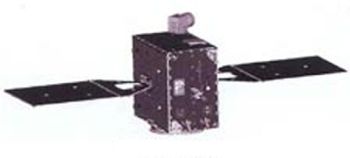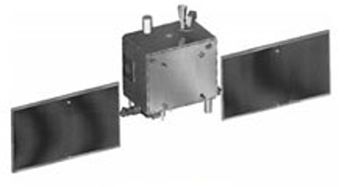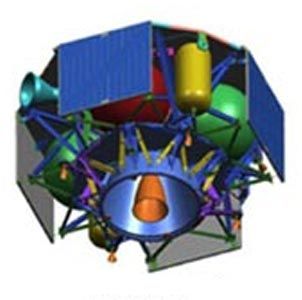
Home - Search - Browse - Alphabetic Index: 0- 1- 2- 3- 4- 5- 6- 7- 8- 9
A- B- C- D- E- F- G- H- I- J- K- L- M- N- O- P- Q- R- S- T- U- V- W- X- Y- Z
Mitex
 USA 187 Credit: Manufacturer Image |
AKA: Microsatellite Technology Experiment. Status: Operational 2006. First Launch: 2006-06-21. Last Launch: 2006-06-21. Number: 3 . Gross mass: 250 kg (550 lb).
The Microsatellite Technology Experiment was a classified mission, believed to be a test of prototype inspect-and-disable satellites that would control the constellation of geostationary satellites on which the world depends for television reception and communications.
Each microsatellite, one built by Orbital Sciences, and the other by Lockheed Martin, had a mass of about 250 kg. They were believed to be solar-powered and equipped with propulsion systems that would allow them to rendezvous with geosynchronous satellites. Once they had reached the satellite, they would presumably be capable of destroying, disabling, or jamming them.
This was a long-suspected or -expected capability, since geosynchronous satellites had proven vital in modern netcentric warfare in providing high-bandwidth communications with forces on the ground. Such satellites could either jam or interfere with such communications in more sophisticated ways. They also could interfere with communications satellites broadcasting information contrary to American interests; disable missile early warning or weather satellites of the enemy; or inspect and determine the real nature of enemy satellites which may also have a wartime search-and-destroy role (there had been Russian launches in this suspect category).
To deliver the two satellites to near-synchronous orbit, a Naval Research Laboratory liquid propellant bus equipped with a 400 N main engine and solar panels was used. This suggested that this was a satellite dispenser that could deliver two such inspector satellites to near their targets at geosynchronous orbit, or larger numbers in lower orbits (such as MEO navigation or communication satellite constellations). In an operational scenario the satellites perhaps would remain docked to the bus in orbits in the same planes as enemy constellations of interest, only to be released in the event of war.
More at: Mitex.
Family: anti-satellite. Country: USA. Launch Vehicles: Thor, Delta, Delta 7925-9.5. Launch Sites: Cape Canaveral, Cape Canaveral LC17A. Agency: USAF, OSC. Bibliography: 2, 12844.
 | MITEx B Credit: Manufacturer Image |
 | MITEx Upper Stage Credit: Manufacturer Image |
2006 June 21 - . 22:15 GMT - . Launch Site: Cape Canaveral. Launch Complex: Cape Canaveral LC17A. Launch Pad: SLC17A. LV Family: Thor. Launch Vehicle: Delta 7925-9.5.
- USA 187 - .
Payload: MiTEx-A. Mass: 225 kg (496 lb). Nation: USA.
Agency: DARPA.
Manufacturer: OSC.
Class: Technology.
Type: Navigation technology satellite. Spacecraft Bus: GEOStar-1.
Spacecraft: Mitex.
USAF Sat Cat: 29240 . COSPAR: 2006-024A. Apogee: 36,222 km (22,507 mi). Perigee: 184 km (114 mi). Inclination: 25.25 deg. Period: 639.26 min.
The Microsatellite Technology Experiment was a classified mission, believed to be a test of prototype inspect-and-disable satellites that would control the constellation of geostationary satellites on which the world depends for television reception and communications. Each microsatellite, one built by Orbital Sciences, and the other by Lockheed Martin, had a mass of about 250 kg. They were believed to be solar-powered and equipped with propulsion systems that would allow them to rendezvous with geosynchronous satellites. Once they had reached the satellite, they would presumably be capable of destroying, disabling, or jamming them. To deliver the two satellites to near-synchronous orbit, a Naval Research Laboratory liquid propellant bus equipped with a 400 N main engine and solar panels was used.
- USA 188 - . Payload: MiTEx-B. Mass: 225 kg (496 lb). Nation: USA. Agency: DARPA. Manufacturer: Lockheed. Class: Technology. Type: Navigation technology satellite. Spacecraft Bus: GEOStar-1. Spacecraft: Mitex. USAF Sat Cat: 29241 . COSPAR: 2006-024B.
- USA 189 - . Payload: MiTEx Vehicle. Mass: 250 kg (550 lb). Nation: USA. Agency: NRL. Class: Technology. Type: Navigation technology satellite. Spacecraft Bus: GEOStar-1. Spacecraft: Mitex. USAF Sat Cat: 29242 . COSPAR: 2006-024C.
Back to top of page
Home - Search - Browse - Alphabetic Index: 0- 1- 2- 3- 4- 5- 6- 7- 8- 9
A- B- C- D- E- F- G- H- I- J- K- L- M- N- O- P- Q- R- S- T- U- V- W- X- Y- Z
© 1997-2019 Mark Wade - Contact
© / Conditions for Use